ENM1102 Manual Sketching Task 2
| Task Number | 2 |
| Task Title | Manual Sketching: Line Types, Isometric Drawings, Shading |
|
Notes Students Online (off- | There will be no option to resubmit this assessment if the due date/time is missed. For example, a medical certificate showing the student was unfit for their studies over several days (within the entire submission period) will not suffice as the on-campus completion time is only a fraction of time being allowed for its completion (~45min). In the online (off-campus) enrolment mode, several days are given for practice and completion. Missing a few days is not considered an exceptional (eligible) circumstance. For extended absences that are supported with documented evidence (e.g, a medical certificate showing the student was unfit for studies for 90-100% of the entire timeframe for completing this task), these maybe considered subject to the details noted in the Unit Plan: section Assessment information – Absence from Drawing tasks (manual sketching, CAD). |
|
Notes - Enrolled On- (Joondalup) | Those who miss a lab are normally not afforded a second sitting for the same task unless exceptional (eligible) circumstances can be established. Students who arrive late to the lab are afforded no extra time. Students who miss the on-campus (Joondalup) lab slot but have documented evidence (e.g, a medical certificate showing the student was unfit on the day of the lab), these maybe considered subject to the details noted in the Unit Plan: section Assessment information – Absence from Drawing tasks (manual sketching, CAD). |
| Resources Provided | N/A |
| Resources you Will Provide | Three sheets of plain (white) A4 copy paper. Complete hand drawings on a single side of each sheet (not double sided). Lodge this work as a single PDF file (scan). Ensure each A4 sheet appears as full-scale (100%, do not zoom in or out when scanning). This means a 0.5mm line (on the drawing sheet) when converted to PDF needs to remain 0.5mm thick when printed (tasks for online students will be printed for marking). |
| Labelling (All Students) |
Using everyday writing and with a pen (ink), write your (1) full name, (2) ECU student id number, (3) Enrolment mode (Online or On- |
Important notes for the completion of this assessment
1. To be graded for this task, you must do all the following:
- Firstly, complete your hand sketches as per the instructions given;
- Second, convert the drawing sheets into a single PDF file featuring multiple pages (not multiple PDF files, multiple JPEG’s or other image file formats); and
- Thirdly, access the Blackboard site transfer your answers to the online form (accessible inside Blackboard) which will allow your work to be graded.
2.It is also advisable that you should.
- Thirdly, retain the softcopy (original file) until the end of this semester in the event you wish to query any of the marks given or seek feedback on your solution

Question - How do I save the answer for a specific question?
Answer - You click ‘Save Answer” against the individual question(s). This merely saves your answer on the system, but it does not lodge that answer for marking. When you click “Save and Submit” you will lodge the entire assessment and it cannot be altered any further. There is only one opportunity to “Save and Submit”.

Marks given for part or question
Question - Can I do continuous or interrupted completion?
Answer - The entire assessment does not have to be completed in one sitting. However, it does need to be saved and submitted by the due date/time. See the first page of this assessment for dates/times. To exit after saving your work (but not saving and submitting), simply close the browser window.
Question - Can I have multiple attempts online?
Answer - Provided you do not click “Save and Submit”, you can go back and alter the saved answers. However, once you click “Save and Submit”, your answers are locked in and cannot be redone. So, there is only one attempt to this assessment.
Question - How do I lodge my submission before the due date/time?
Answer - You click “Save and Submit”. You should plan to lodge at least 24hrs before the due or expiry time to ensure you are not affected by Blackboard site outages etc.
Confirming the Lodgement Once You “Save and Submit”
- When you submit and save your assessment (Blackboard names each of these a “Test”), you will receive a message similar to the one below.
- Your message should state Test saved and submitted, and detail the start time, submission time and time used. If you select OK to review results, you will not see your test score, as it is being withheld until after the grades have been moderated.
- In My Grades, you should also see confirmation of your test completion, with a message similar to this:
- Test scores will be made available when announced in your unit.

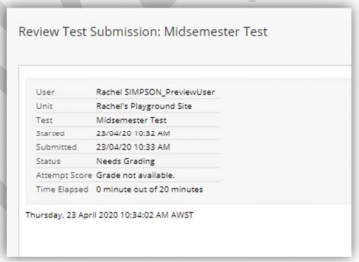
Skills Practiced
This task will allow you to practice and develop several manual sketching skills.
- Sketching (freehand) different line types on plain paper
- Continuous thick lines (thickness=0.5mm) o For techniques, refer to Chp1 - Boundy (Table 1.3, Table 1.4, Type A lines)
- Continuous thin lines (thickness=0.25mm) o For techniques, refer to Chp1 - Boundy (Table 1.3, Table 1.4, Type B lines)
- Thin dashed lines (thickness=0.25mm) o For techniques, refer to Chp1 - Boundy (Table 1.3, Table 1.4, Type E lines)
- Thin chain lines (thickness=0.25mm) o For techniques, refer to Chp1- Boundy (Table3, Table 1.4, Type G lines)
- Developing sharp ends, correct line thickness and dash-gap proportions
(where applicable) o For techniques, refer to Chp3 - Giesecke (Fig 3.24) and Chp4 - Bethune (sec 4.5)
- Demonstrating scribing of letters and numerals o For techniques, refer to Chp1 - Boundy (Table 1.12 and Sec 1.3) Demonstrating cleanliness and neatness of sketching sheets
- Sketching (freehand) isometric drawings and shading on plain paper
- Defining isometric axes using feint construction lines o For techniques, refer to Chp8 - Boundy (Fig 8.9)
- Drawing isomeric lines (parallel to the isometric axes) o For techniques, refer to Chp8 Boundy (Fig 8.9)
- Initially, generating feint construction lines to define dominant features o Note: retain these feint construction lines in the final drawing (do not erase).
- Subsequently, thickening-in (or darkening) feint construction lines to complete a sketch
- Maintaining aspect ratio’s (relative proportions) for shape (i.e., proportions of length, height and depth should be retained
- Applying shading (hatching or stippling) o For techniques, refer to Chp3 - Giesecke (Fig 3.14, Fig 3.15)
- Demonstrating cleanliness and neatness of sketching sheets
Assessment
- You do not need to add dimensions to any of the sketches.
- You do not need to show centrelines (on circular or arc features).
- You do not need to add a drawing frame or title block.
- You will be assessed for completeness and correctness of the sketching made, the overall quality of the lines and (drawing) cleanliness of the sheets. You are responsible for ensuring the quality of the scan provided (in the PDF) reflects the task requirements.
- If scanning your drawings and then converting them to PDF, ensure the PDF includes only two
- This assessment includes two sections: Section A, Section B.
- Section A is the same for all lab groups.
- Section B covers two parts: Part 1, Part 2 drawn to different views based on the lab group you are enrolled in. If you complete the wrong requirements, you will receive zero.
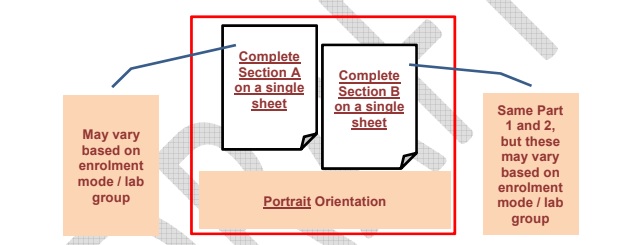
Tools / Instruments / Techniques
- Tasks are to be attempted using freehand sketching with (traditional, graphite or mechanical) p
- No drawing templates, stencils, rulers or other drawing aids are to be used in scribing lines.
- You can however use:
- a ruler to self-check line weights (i.e., how many 0.5mm lines can you fit between two graduations on a ruler) and proportions (dashes, gaps)
- a protractor to check angles
Completing the Task
Section A - Sketching (freehand) different line types on plain paper
(A.1) Draw a block of 15 (horizontal) continuous thick lines (thickness=0.5mm)
Each line should be around 50-70mm in length (judge this by the ‘eye’) Draw the first line type, then all the other similar lines parallel to it (beneath). Ensure all line weights are consistent and appropriate for this type of line.
[7.5% of max marks]
Tips: Leave a vertical distance (gap) of about 10mm between each of the parallel lines.
At the base of the lines drawn in (1.1), use neat handwriting and scribe “CONTINUOUS THICK LINES”.
Tips: Use character heights/spacing for general notes, materials lists, dimensions.
(A.2) Draw a block of 15 (horizontal) continuous thin lines (thickness=0.25mm) Each line should be around 50-70mm in length (judge this by the ‘eye’) Draw the first line type, then all the other similar lines parallel to it (beneath). Ensure all line weights are the same and appropriate for this type of line.
[7.5% of max marks]
Tips: Leave a vertical distance of about 10mm between each of the lines.
At the base of the lines drawn in (1.2), use neat handwriting and scribe
“CONTINUOUS THIN LINES”
Tips: Use character heights/spacing for general notes, materials lists, dimensions.
(A.3) Draw a block of 7 (horizontal) thin dashed lines followed (elsewhere on your sheet)
with another block of 7 (vertical) thin dashed lines (thickness=0.25mm)
Each line should be around 50-70mm in length (judge this by the ‘eye’)
Draw the first line type, then all the other similar lines parallel to it (beneath or beside it). Ensure all line weights, dashes/gaps are consistent and appropriate for this type of line.
[7.5% of max marks]
Tips: Leave a vertical distance of about 10mm between each of the lines.
At the base of the lines drawn in (1.3), use neat handwriting and scribe
“THIN DASHED LINES”
Tips: Use character heights/spacing for general notes, materials lists, dimensions.
(A.4) Draw a block of 7 (horizontal) thin chain lines followed (elsewhere on your sheet)
with another block of 7 (vertical) thin chain lines (thickness=0.25mm)
Each line should be around 50-70mm in length (judge this by the ‘eye’)
Draw the first line type, then all the other similar lines parallel to it (beneath or beside it). Ensure all line weights, dashes/gaps are consistent and appropriate for this type of line.
[7.5% of max marks]
Tips: Leave a vertical distance of about 10mm between each of the lines.
At the base of the lines drawn in (1.4), use neat handwriting and scribe
“THIN CHAIN LINES”
Tips: Use character heights/spacing for general notes, materials lists,
Section B - Sketching (freehand) isometric drawings and shading on plain paper
Provide an isometric drawing for each of the parts depicted below.
Add shading using either hatching or stippling.
In completing the drawings, retain all your (feint) isometric axes and other construction lines as these form part of the assessment (i.e., do not erase these).
Do not show hidden detail.
Tips: The image for Part 1 and Part 2 may have not been taken/shown at the appropriate angles for the isometric axes. As such, you may need to spatially reorient the parts (off paper, i.e., “in your imagination”) before starting to draw.
Isometric Drawing (Part 1 + Part 2)
Breakdown as follows:
15% - Isometric axes are drawn at correct alignment
- 30 or 90 (as applicable)
15% - Relative proportions of features are retained
- Features in Part 1 and Part 2 maintain their aspect ratio’s
15% - Completeness of the features
- Features on Part 1 and Part 2 are all drawn
10% - Isometric lines for edges are consistently parallel to the isometric axes
10% - Line quality
- Continuous lines are drawn to the right weight and consistent throughout
Shading (Part1+Part 2)[5% of max marks]
Each part must only have one form of shading applied (either hatching or stippling)
The same type of shading need not be applied to both parts (i.e., you can apply shading to both, hatching to both, or shading to one part and hatching to the other).
| Enrolment Mode (Lab Session) | Part 1 | Part 2 |
| Online (Off-Campus) |  | 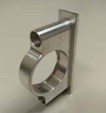 |
|
On-Campus MON 1030-1230 | 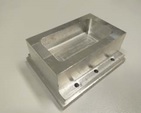 | 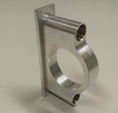 |
| On-Campus MON 1330-1530 |  |  |
| On-Campus MON 1530-1730 |  |  |
| On-Campus TUE 1330-1530 |  | 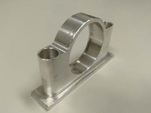 |
| On-Campus TUE 1530-1730 |  | 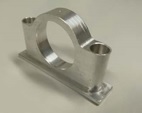 |
| On-Campus THU 1330-1530 |  | 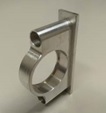 |
Summary allocation of image orientations to lab groups.

Geometrical features in Part 1 and Part 2 (specific views to be drawn by students in different enrolment modes / lab groups not shown above).
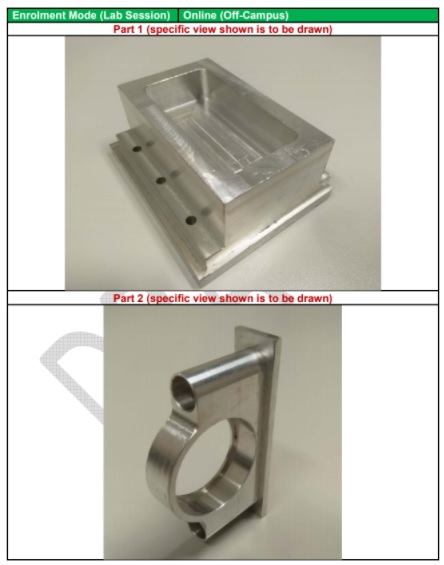




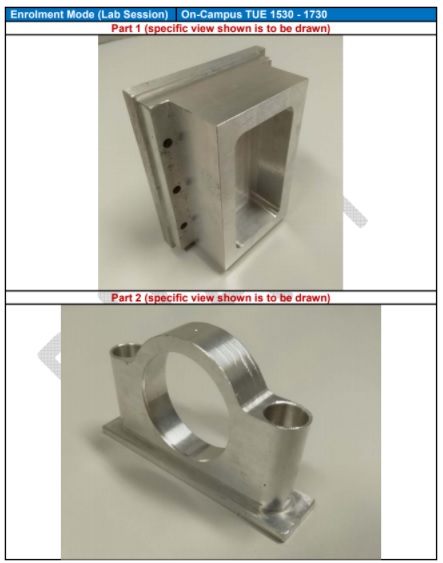

Resources
- 24 x 7 Availability.
- Trained and Certified Experts.
- Deadline Guaranteed.
- Plagiarism Free.
- Privacy Guaranteed.
- Free download.
- Online help for all project.
- Homework Help Services

